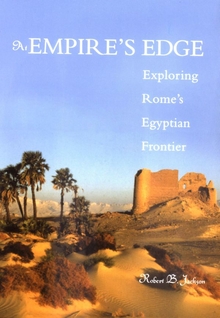At Empire's Edge
WARNING
You are viewing an older version of the Yalebooks website. Please visit out new website with more updated information and a better user experience: https://www.yalebooks.com
Exploring Rome`s Egyptian Frontier
Robert B. Jackson
When Egypt became a province of the Roman Empire in 30 B.C. after the deaths of Antony and Cleopatra, its vast and mysterious frontier lands had an important impact on the commerce, politics, and culture of the empire. This engrossing book—part history and part gazetteer—focuses on Rome’s Egyptian frontier, describing the ancient fortresses, temples, settlements, quarries, and aqueducts scattered throughout the region and conveying a vivid sense of what life was like for its inhabitants.
Robert B. Jackson has journeyed, by jeep and on foot, to virtually every known Roman site in the area, from Siwa Oasis, forty-five kilometers from the modern Libyan border, to the Sudan. Drawing on both archaeological and historical information, he discusses these sites, explaining how Rome extracted exotic stone and precious metals from the mountains of the Eastern Desert, channeled the wealth of India and East Africa through the desert via ports on the Red Sea, constructed and manned fortresses in the distant oases of the Western Desert, and facilitated the expansion of agricultural communities in the desert that eventually experienced the earliest large-scale conversions to Christianity in Egypt. Elegantly written and illustrated with many handsome photographs, the book will be a treasured resource for archaeologists, classicists, and travelers to the region.
Robert B. Jackson has journeyed, by jeep and on foot, to virtually every known Roman site in the area, from Siwa Oasis, forty-five kilometers from the modern Libyan border, to the Sudan. Drawing on both archaeological and historical information, he discusses these sites, explaining how Rome extracted exotic stone and precious metals from the mountains of the Eastern Desert, channeled the wealth of India and East Africa through the desert via ports on the Red Sea, constructed and manned fortresses in the distant oases of the Western Desert, and facilitated the expansion of agricultural communities in the desert that eventually experienced the earliest large-scale conversions to Christianity in Egypt. Elegantly written and illustrated with many handsome photographs, the book will be a treasured resource for archaeologists, classicists, and travelers to the region.
Robert B. Jackson is chair of the department of history at The American International School of Muscat, Sultanate of Oman.
A main selection of the Discovery Channel Book Club
"Robert B. Jackson , who is presently chairing the history department at the American International School of Muscat in the Sultanate of Oman, has devoted more than twenty years to this project. The results are impressive. . . . An academic text that would not be out of place in a tourist’s backpack, the work should attract a wide readership. It will appeal to classicists, archaeologists, and ancient historians who want to know the current state of research in the Egyptian deserts. Anyone, however, who proposes to explore these deserts will find it indispensable. As a travel guide, it supersedes everything currently in print on this remote and inhospitable region."—John K. Evans, History
“A concise and excellent introduction to Rome’s Egyptian frontier. Jackson has a remarkable ability to evoke the atmosphere of a site by describing his own experience. The book is easy to read and difficult to put down.”—Rudolf Winkes, Brown University
“Written for students and the general reader, this volume, besides providing otherwise inaccessible information, is meant to draw attention to the importance of these sites, which are being vandalized and neglected. A superbly written work of major importance for laypersons and scholars; recommended for history and travel collections.”—Library Journal
“Easy to read and highly informative.”—John Whitehorne, Bryn Mawr Classical Review
ISBN: 9780300088564
Publication Date: March 11, 2002
Publication Date: March 11, 2002
384 pages, 6 1/8 x 9 1/4
94 b/w illus.
94 b/w illus.








